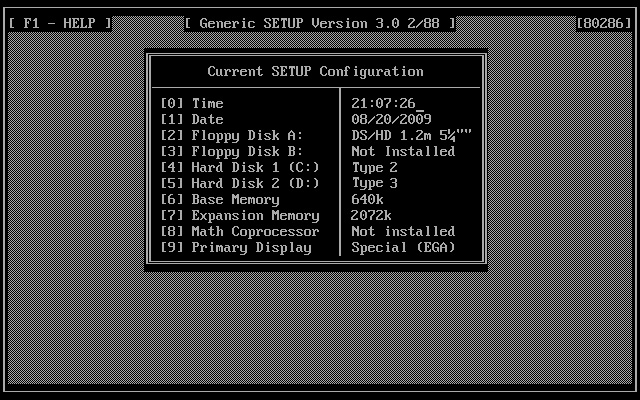BIOS Downloads
Setup Utilities
Most PCs have their BIOS setup built into one or two ROM chips on the motherboard, accessed via a key or combination of keys, such as DEL, ESC, Ctrl+Alt+Esc, etc. But early AT-compatibles required a software program to set the BIOS settings. This section provides some of these.
BIOS Dumping / Flashing Tools
Dumping your BIOS ROM to file can be useful as a backup in case your chip dies and you need to get a new EEPROM burned to replace it.
The tools below can be used to dump the contents of the ROM BIOS area of memory to a file, from which you can then write back to an empty EEPROM. You will need to know the starting address and size (in KB) of your BIOS - this can be found by running Microsoft Diagnostics (MSD.EXE in MS-DOS 6.0). It will tell you what address region your system ROM occupies, and also for any option ROMs (video, hard drive controller, etc.) you have installed.
| Product | Version | Year of Release | Comments | Download |
|---|---|---|---|---|
| BIOS | v1.35.1 | A full-featured DOS tool that can be used to show some BIOS information, save/load BIOS data, dump the ROM to file, find BIOS passwords and more. | Click | |
| DUMPPC | - | 2000 | A utility for saving the
memory region 0xc000:0 - 0xf000:0xffff
(the usual ROM area) The ZIP file includes source code. Warning: On newer systems, the BIOS does not fully reside in this memory area. |
|
| DUMPAT | - | 2000 | A utility for 386s and higher to save the
memory region "protected mode rom area" (0xfff0000 - 0xffffffff on 386) The zip file includes source code. |
|
| DUMP1000 | - | 2000 | In addition to using DUMPPC on a Tandy, this utility for saving the bankswitched rom (7 or 15 64kbyte banks at 0xe0000) on Tandy 1000rl, 1000rlx, 2500xl, ... | |
| PCjrCart | 1.1 | - | Cartridge and ROM BIOS extension utility; finds and writes to disk. PCjrcart can provide a pure dump to file, but it can also scan the BIOS area for extensions. This is useful for dumping the BIOS on cards like SCSI adapters, VGA cards, etc. By Mike Brutman. |
|
| SaveROM | - | - | ||
| Uniflash | 1.22 | 2001 | A BIOS flash program, used to write a new BIOS on your FLASH ROM Chip. Includes source code in Pascal. Brand name flashers have a tendency to be unstable (this is especially true for AWDFLASH). *Requires an 80386 CPU minimum, <2GB RAM, MS-DOS 4.0 or higher, a known flash ROM chip, and a supported PCI chipset* |
Click |
Note: you can use MS-DOS' own DEBUG command to dump any block of memory to a file. Here's an example that saves 32 KB starting at F000 to a file called MYF000.bin:
C:\> DEBUG
-N MYF000.BIN (resulting file will be named MYF000.BIN)
-R BX (set BX=0000H/CX=8000H as count of bytes to write, 00008000H = 32K)
BX 0000
:0000
-R CX
CX 0000
:8000
-M F000:0 8000 0100 (copy 32K bytes from F000:0 to offset 0100 in local segment)
-W 0100 (write from offset 0100 in local segment)
Writing 8000 bytes
-Q
Other Utilities
| Product | Version | Year of Release | Comments | Download |
|---|---|---|---|---|
| PORT80.EXE | - |
? |
Returns any POST (Power-On Self Test) errors that occurred last. **Cannot be run in Windows' DOS mode - requires real DOS** |
|
| TuffTest Lite | 1.52F | ? |
